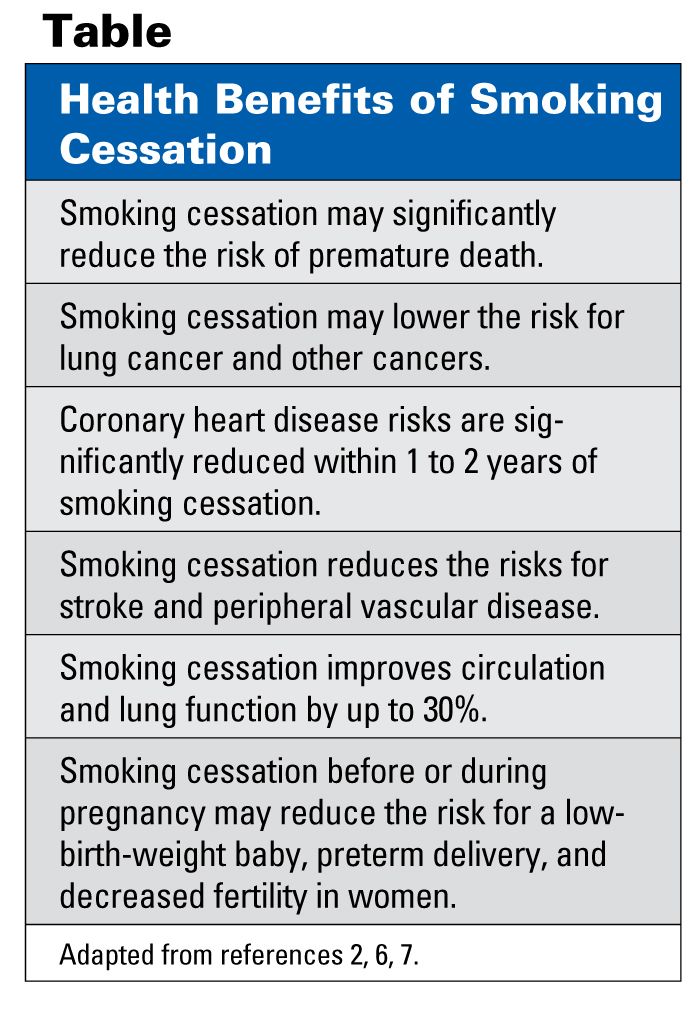Publication
Article
Pharmacy Times
A Pharmacist's Guide to OTC Therapy: Smoking Cessation Products
Author(s):
Tobacco smoking continues to be the leading cause of preventable disease and death in the United States, and annually, an estimated 443,000 individuals die prematurely from smoking or exposure to secondhand smoke, and another 8.6 million have a serious illness caused by smoking.1,2
An estimated 23.5% of men and 18.1% of women in the United States are smokers.3 According to statistics from the Centers for Disease Control and Prevention (CDC), an estimated 70% of adult smokers in the United States want to quit smoking.4 Annually, more than 35 million smokers attempt to quit smoking, but only fewer than 5% will reach their 1-year anniversary.5 Many smokers would agree that quitting is easier said than done, and for many smokers, finding the most efficacious means to do so may seem overwhelming and impossible.
Many smokers might be motivated to attempt smoking cessation if they were aware of the health benefits of smoking cessation. A 2004 publication of the Surgeon General’s Report, entitled The Health Consequences of Smoking, stated that smoking adversely affects nearly every organ system in the body and can play a role in the development of various medical conditions.6
Health Benefits of Smoking Cessation
In 1990, the Surgeon General released a report outlining the various health benefits of smoking cessation.

Smoking cessation can significantly decrease the occurrence of coronary heart disease and other forms of cardiovascular disease.2,6 Smoking cessation also is important in the medical management of many contributing factors associated with myocardial infarctions, such as atherosclerosis, thrombosis, coronary artery spasm, and cardiac arrhythmia.2 Smoking cessation also may assist in the management of other medical conditions, such as arteriosclerotic peripheral vascular disease and chronic obstructive pulmonary disease.2 Examples of other health benefits associated with smoking cessation can be found in the Table.2,6,7
Nicotine Replacement Therapy
Nicotine replacement products are the most commonly used pharmacotherapy for smoking cessation, and those currently available as nonprescription nicotine replacement therapy (NRT) products include gum, patches, and lozenges. NRT products assist individuals who wish to quit smoking by providing smokers with a nontobacco source of nicotine, which assists in decreasing nicotine cravings and withdrawal symptoms that typically occur after abstinence from tobacco.6 The use of NRT products also enables patients to focus on the behavioral modifications necessary to quit smoking.6
Nicotine Gum
Nicotine polacrilex gum, such as Nicorette (GlaxoSmithKline), is a resin complex of nicotine and polacrilin in a sugar-free (contains sorbitol) chewing gum base.6 Nicotine polacrilex gum is available in 2- and 4-mg strengths and in various flavors, including original (tobacco), mint (various), fruit, cinnamon, and orange.6,8 The 2-mg strength is recommended for those who smoke fewer than 25 cigarettes per day. Those who smoke more should use the 4-mg strength.6 In general, the peak concentrations of nicotine are achieved within 30 minutes after beginning to chew the gum, and then slowly decrease over the next 2 to 3 hours.6,8
It is important to inform patients about the proper use of this product, including using the “chew and park” method, which involves not chewing the gum continuously, but to initially chew the gum and then let the gum sit between your gums and cheek to allow for the absorption of the nicotine. The adverse effects that a patient may experience while using NRT gum can include unpleasant taste, dyspepsia, jaw muscle soreness, hypersalivation, hiccups, or mouth irritation.6,8 The effectiveness of the gum can be reduced by ingestion of acidic beverages. Patients should not eat or drink, except water, for about 15 minutes before or while chewing the gum. The recommended use of NRT gum is 1 piece of gum every 1 to 2 hours while awake during weeks 1 through 6; followed by 1 piece every 2 to 4 hours during weeks 7 through 9; and 1 piece every 4 to 8 hours during weeks 10 through 12. Patients should be advised to not use more than 24 pieces per day.5,6,8
Nicotine Polacrilex Lozenges
NRT products also are available as the nicotine polacrilex lozenge (Commit Lozenge, GlaxoSmithKline), which is a resin complex of nicotine and polacrilin available in regular-, mint-, cherry-, or cappuccino-flavored, sugar-free (aspartame) and in 2- and 4-mg strengths.6,9 The 4-mg strength should be used for those individuals who smoke their first cigarette within 30 minutes of waking up, and the 2-mg strength is for those who smoke their first cigarette more than 30 minutes after waking.6 Although the pharmacokinetics of both the gum and lozenge are comparable, the lozenge delivers approximately 25% more nicotine than the equivalent dose of nicotine gum, due to the complete dissolution of the dosage form.6 During the initial 6 weeks of therapy, patients should use 1 lozenge every 1 to 2 hours while awake.6 Patients can use additional dosages and should be advised to not use more than 5 lozenges in 6 hours and to not use more than 20 lozenges in a 24-hour period. The recommended dosing intervals for lozenges are similar to those of nicotine gum.6,9 Adverse effects and interaction with acidic beverages are similar to those associated with use of the gum.5
Nicotine Transdermal System The nicotine transdermal system continually releases low levels of nicotine into the body over a 24-hour period.6 Transdermal products available include Nicoderm CQ with Smart Control patch (GlaxoSmithKline), Habitrol patch (Novartis Consumer Health), and generic formulations, as well. These patches are available in steps 1 to 3 in strengths of 7, 14, and 21 mg. The dosage of the patch is dependent upon the number of cigarettes an individual smokes daily. If an individual smokes more than 10 cigarettes per day, the 21-mg patch should be the initial strength used for 6 weeks, then the 14- and 7-mg patches each for 2 weeks. Individuals who smoke fewer cigarettes may start with the 14-mg dosage for 6 weeks and then use the 7-mg strength for 2 weeks.6,10,11
Local skin irritations, such as pruritus and erythema, are the most commonly reported adverse effects. Skin irritations can be reduced or prevented by rotating the application of patches on a daily basis. Some individuals have reported having abnormal or vivid dreams, headache, or insomnia.6
The Role of the Pharmacist
Whereas tobacco smoke interacts with various pharmacologic agents, through pharmacokinetic or pharmacodynamic mechanisms that may result in decreased therapeutic efficacy or less commonly increased toxicity, pharmacists are key in identifying possible drug interactions and contraindications associated with tobacco use.6 Examples of drug interactions with tobacco smoke include hormonal contraceptives, beta-blockers, theophylline, and benzodiazepines.6 Patients with pre-existing medical conditions, such as those who have experienced recent myocardial infarctions, those with severe angina, those with history of arrhythmia, uncontrolled hypertension, active peptic ulcer disease, those who are pregnant or breast-feeding, or individuals younger than 18 years of age should always consult their primary care provider prior to using any of these products.6 Pharmacists can provide patients with suggestions of various nonpharmacologic methods that can be used in conjunction with the use of these OTC smoking cessation products. Pharmacists also can encourage patients to seek assistance from counseling services for motivation and to increase the chances of successful smoking cessation; individuals can contact the program sponsored by the US Department of Health and Human Services, by calling 800-QUIT-NOW (800-784-8669), or visiting http://1800quitnow.cancer.gov/, or patients can reach out to the CDC National Center for Chronic Disease Prevention and Health Promotion Office on Smoking and Health (800-CDCINFO; [email protected]).







